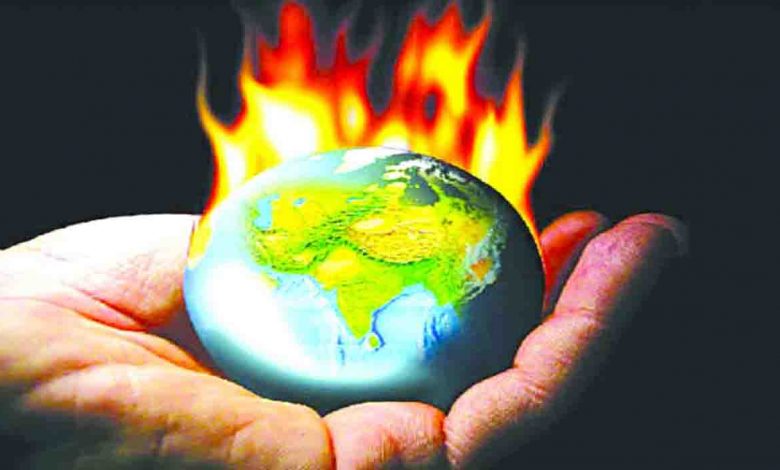The horror of climate change in the west

Monday, 27 September 2021 | Vir Singh
GUEST COLUMN
 Vir Singh
Vir Singh
Before the fresh Intergovernmental Panel on Climate Change (IPCC) report stirred all the minds concerned with the future of the planet, the mercury had reached 46.6 °C in the village of Lytton in the province of British Columbia in Canada, creating new history of global warming in the western region of the world known for its cold climate. Several schools and business establishments in the province were closed and Covid-19 vaccination clinics were relocated. A forest fire completely destroyed a Canadian village. The heat killed hundreds of people in the northwestern United States in a region famous for its cold fog. The fire spread to 12 states in the west of America. The heat wave spewing flames in the northern Rocky Mountains faded away the current wave of Covid-19. In Russia’s capital Moscow, the heat wave broke the 120-year record. The worst ever floods in Europe in Germany, Belgium and the Netherlands killed 165 people.
The western media has been flooded with the news focused on record heat waves and unprecedented global warming trend in this summer. In the future, such dismal scenarios will be more widespread and terrifyingly visible from place to place in the world; such fears are also being expressed by the media and from experts as well as common people. Climate change is now clearly taking its toll due to global warming. Its reality is also evident from the recent IPCC report. A team of international researchers has concluded that the extraordinary heat wave certainly would not have occurred without the global warming. A warmer atmosphere has more moisture, and already heavy rains are occurring in the midst of many storms around the world. Of course, extreme weather events will continue to intensify more and more as a result of global warming.
Disasters caused by global warming have left deep wounds in much of the developing world. For example, crops have been wiped out in Bangladesh, villages have been leveled in Honduras, severe storms and heavy rainfall events in India have caused panic in many regions and the existence of small island nations has been in doldrums.
One important question posed amidst gloomy scenario of global warming is- will increasing environmental disasters in the developed world affect the world’s most influential countries and their companies and motivate them to reduce emissions of greenhouse gases? Will the United Nations-led climate summit to be held in Glasgow in Scotland in November 2021 pass a resolution that will lead to the expected reduction in carbon emissions towards climate regulation, and will there be any curbs on polluting companies?
In fact, after the 2015 Paris Climate Agreement, which set targets to avert ill effects on the planet’s climate, global carbon emissions have continued to rise unabatedly. China is the world’s largest carbon emitter today, according to IPCC. A decline of carbon emissions in Europe and North America has been recorded, but it is not enough to limit global warming. Climate models worked out by climate scientists have revealed the devastating effects of rising temperatures. A detailed scientific assessment in 2018 warned that failure to prevent average temperatures from rising beyond 1.5 °C compared to pre-Industrial era could lead to disastrous consequences ranging from flooding of coastal cities to crop failure in various regions.
The Paris Climate Agreement has called for halving emissions by 2030 to set out a pragmatic goal of bringing the world out of climate chaos, but the way, in which emissions are rising, it seems unlikely that this goal will be reached. The global average temperature has increased by more than 1.0 °C since 1880. Pre-Paris climate agreements had set a limit of 1.5 °C for temperature rise, which was raised to 2.0 °C in the Paris Agreement. The recent IPCC report predicts a 1.5 degrees rise by 2040. But if the pace of global carbon emissions remains the same, this much rise in the temperature will be recorded by 2035 and the extent to which the temperature will reach by the end of the century can be well predicted. When the global weather behaviour has become so severe due to the increase in temperature only by one degree Celsius, then what will be consequences of climate change after the temperature rises by two degrees, which is the limit set by the Paris Climate Agreement?
One of the unfolding realities that the world’s most vulnerable island nations are vulnerable to climate change is highlighted by a quote from former President of the Maldives, Muhammad Nashir, who himself is horrified by the threat of sea level rise. “While all are equally affected, this tragic event (in Europe and North America) is a reminder that no one is safe in a climate emergency, whether they live in a Western European state or a small island nation like mine,” he said.
With a sense of invincibility fueled by the rapid release of greenhouse gases into the atmosphere and the consequent economic prosperity that breaks the natural climate cycle of the biosphere, the condition of the developed world is such that catastrophic floods have killed more than 1,000 people in America since 2010. Canada is not able to save even its village from forest fires. Developed countries like Germany, Belgium and the Netherlands lose hundreds of lives in one stroke.
The climate change advancing towards a catastrophe across Europe and North America has exposed two essential facts of science and history- the whole world is neither prepared to stop climate change, nor willing to live with it. The causes, consequences and way out of the global warming are well known, but the greed of staying ahead in competition for economic growth among the nations allows the global climate pattern going berserk. The dismal situation of emerging terrorism in terrorist states of Pakistan and Afghanistan and the same getting political recognition by some developed countries is to add fuel to fire to the processes of climate catastrophe.
(The author is a former professor of Environmental Science in GB Pant University of Agriculture and Technology. Views expressed are personal)






